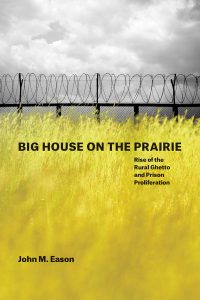John M. Eason, Big House on the Prairie, and the rural prison boom

Working crucial arguments from his book Big House on the Prairie down the line, John M. Eason takes on the rise of the rural prison industry—and its role as impediment to criminal justice reform—for the Conversation; excerpt after the jump.
***
As I explain in my book, “Big House on the Prairie,” the number of prisons in the U.S. swelled between 1970 and 2000, from 511 to nearly 1,663. Prisons constructed during that time cover nearly 600 square miles, an area roughly half the size of Rhode Island. More than 80 percent of these facilities are operated by states, approximately 10 percent are federal facilities and the rest are private.
The prison boom is a massive public works program that has taken place virtually unnoticed because roughly 70 percent of prisons were built in rural communities. Most of this prison building has occurred in conservative southern states like Florida, Georgia, Oklahoma and Texas.
Much of how we think about prison building is clouded by the legacy of racism and economic exploitation endemic to the U.S. criminal justice system. Many feel that prison building is the end product of racist policies and practices, but my research turned up a more complicated relationship.
People of color have undoubtedly suffered from the expansion of prisons, where they are disproportionally locked up, but they have also benefited.
Blacks and Latinos are overrepresented among the nation’s 450,000 correctional officers. Prisons are also more likely to be built in towns with higher black and Latino populations. Many may be surprised to learn that residents of these often distressed rural communities view local prisons in a positive light.
***
To read Eason’s piece in full (later covered by the Houston Chronicle and Salon), click here.
To read more about Big House on the Prairie, click here.